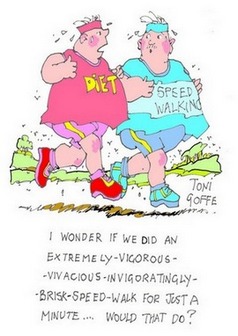Recent Advances – Diabetes
In my last blog I said that I had finished with obesity for the time being – but maybe that was not quite correct. Today my subject is diabetes – more specifically Type 2 Diabetes (T2DM) – and, of course, obesity and T2DM are very closely related. Over the past six decades the incidence of obesity has about doubled and the incidence of T2DM has increased sixfold! The one follows the other.
T2DM is caused mainly by eating too much and moving too little – with a moderate contribution from inherited characteristics. Several recent investigations have helped to clarify the role of exercise and lack of it in T2DM and its complications.
The UK Biobank project
I will be reporting a number studies from this enormous research undertaking so here is some information about this ground-breaking project.
UK Biobank is a large-scale biomedical database and research resource containing genetic, lifestyle and health information and biological samples from half a million UK participants.
It is the most comprehensive and widely-used dataset of its kind, and is globally accessible to approved researchers who are undertaking health-related research that is in the public interest, whether they are from academic, commercial, government or charitable settings.
UK Biobank is helping to give us research data to help our understanding of the prevention, diagnosis, and treatment of a wide range of serious and life-threatening illnesses – including cancer, heart
disease and stroke – and T2DM.
Physical activity and prevention of T2DM
A Biobank study of 90,000 participants measured their physical activity for seven days using and accelerometers (sophisticated pedometers). Follow up showed that there was a straight line relationship between the amount of energy expended while they were being monitored and the subsequent incidence of T2DM – the more they did, the lower their risk of diabetes, even after adjusting for body mass index. A daily energy expenditure equivalent to a brisk 20 minute walk lowered the risk of diabetes by about 20%.
The effect of walking speed
We already know that regular exercise helps to prevent T2DM – but what about walking? A systematic review of all the ten relevant published studies looked at walking speed and diabetes risk. The authors categorised walking speed into four levels: “easy” at less than 2mph, “average” at 2-3mph, “fairly brisk” at 3-4mph and “very brisk” at more than 4mph.
Compared with the “easy” group, the “average” group had a 15% lower risk of diabetes, the “fairly brisk” group a 24% lower risk and the “very brisk” a 39% lower risk.
Walking can be an excellent way of keeping fit – but speed is important, not only because of the fitness benefits of going faster but also because that leaves more time to do even more!
Reducing the complications of T2DM
One real harm from diabetes is produced by damage to the small blood vessels which can result in retinopathy (eye damage), nephropathy (kidney damage) and neuropathy (nerve damage). Another Biobank study included 18,092 individuals with T2DM. Self-reported leisure-time physical activity was converted into four categories : no physical activity (PA), below recommendations, at recommendations, and above recommendations.
During a median follow-up of 12.1 years, 672 individuals (3.7%) were diagnosed with neuropathy, 1,839 (10.2%) with nephropathy, and 2,099 (11.7%) with retinopathy. Any level of PA was associated with a lower risk of neuropathy and nephropathy but not retinopathy.
Compared with those reporting no physical activity, the risk of neuropathy was reduced by a third for all levels of PA. For nephropathy the reduction was about 20%. The association with retinopathy, however, was not significant.
Kidney and nerve damage from T2DM are serious complications. These figures indicate that both can be made less likely by walking for about one and a half hours a week.
The effect of exercise on genetic risk
Another Biobank study. Genetics are important in deciding the risk of T2DM. About 15% of diabetics are of normal weight and apparently take enough exercise – it their genes which have let them down.
This study included 60,000 Biobank subjects and compared their genetic risk, their physical activity and their risk of developing T2DM. During a median follow-up of 6.8 years, there was a strong linear dose-response association between moderate-to-vigorous-intensity physical activity (MVPA) and incident T2DM, even after adjusting for genetic risk.
Compared with the least active participants, the risk of having T2DM for higher levels of MVPA were: 0.63 (about two thirds) for 5.3–25.9 min/day, 0.41 (about two fifths) for 26.0–68.4 min/day and 0.26 (about a quarter) for more than 68.4 min/day.
And participants with a high genetic risk who were very active had a lower risk than sedentary people with no genetic risk!
Next time I will be harking back to my favourite subject – frailty.
Comments
I get endless comments from spammers – mostly advertising their products. I get very few from you, the real readers. Please do comment or add queries in the section below.
PS
My apologies for the error on this week’s illustration – a technical problem which has chopped off the top and bottom. The full caption is: “I wonder if we did an extremely-vigorous-vivacious-invigoratingly-brisk-speed-walk for just a minute …would that do?”
Subscribe to the blog
Categories
- Accelerometer
- Alzheimer's disease
- Blood pressure
- BMI
- Cancer
- Complications
- Coronary disease
- Cycling
- Dementia
- Diabetes
- Events
- Evidence
- Exercise promotion
- Frailty
- Healthspan
- Hearty News
- Hypertension
- Ill effects
- Infections
- Lifespan
- Lipids
- Lung disease
- Mental health
- Mental health
- Muscles
- Obesity
- Osteoporosis
- Oxygen uptake
- Parkinson's Disease
- Physical activity
- Physical fitness
- Running
- Sedentary behaviour
- Strength training
- Stroke
- Uncategorized
- Walking



Sounds as if my parents let me down after all !! What an inheritance.
But. I shall keep up my various forms of exercise for as long as I can.